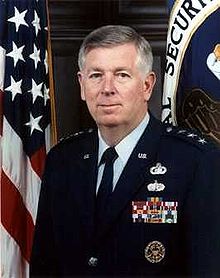Kenneth A. Minihan
Kenneth A. Minihan (born December 31, 1934 in Pampa , Texas ) is a former American Air Force officer. He was director of the National Security Agency (NSA) from 1996 to 1999 .
Career
Minnihan earned a bachelor's degree in political science from Florida State University in 1969 and then served with the US Air Force ( USAF ) until 1999 . During his time with the USAF he was head of the intelligence service of the Air Force and for a short time (from July 1995) of the DIA (Defense Intelligence Agency). In 1996 he became director of the NSA. He later described this office as the most difficult he had ever held.
Work at the NSA
When Minihan took over the NSA, he is said to have experienced a lot of pessimism among the employees, triggered by the continuous downsizing over the past ten years. But also in personal contact Minihan came into conflict with the DDIR , the deputy director ( William P. Crowell ) and other lower-ranking directors in the first few weeks of his tenure . The latter, however, also had disputes among themselves. In September 1997, Crowell left the NSA. Minihan, who, like Bobby Ray Inman 20 years earlier , attached great importance to expanded powers of the director, like Inman, appointed Barbara A. McNamara, a woman, as deputy director of the agency.
Y2K
As the last years of the 20th century passed, Minihan was already worried about the impending computer threat of the Y2K . This is one of the greatest technological and administrative challenges NSA staff has ever faced.
Talk NSA
On May 25, 1998, May 25, 1998, the 45th issue of Talk NSA TV show , Minihan appeared to answer questions from viewers. It was also Minihan who became the first director to host an electronic meeting for NSA workers around the world using an NSA chat room. More than 6000 participants were able to ask short questions.
future
During his reign, Kenneth A. Minihan often looked into the 21st century, where information wars will take precedence over nuclear and conventional military. The NSA is predestined for this, which is why it should often take the lead in later conflicts.
Problems
With an aggressive management style, Minihan tried to break down the cultural barriers between military and civilian employees and the walls between telecommunications intelligence and information security. To overcome the bureaucracy, he put together a Skunk Works team , named after the Lockheed Martin group, which for Minihan acted “always, everywhere, on time and the first time”. Minihan's rigid style led to a decline in motivation among the workforce, as negative criticism was quickly punished.
In Congress we reacted angrily to mini Hans financial demands. In 1998, Parliament's Intelligence Committee even threatened to withhold funds if the agency did not make profound changes in its culture and operation. Ironically, Minihan's accounting system was a mess.
Adding to Minihan's problems was the discovery that an NSA agency bought a first-class computer system and found it was not compatible with the agency's other systems. Multi-million dollar new equipment was purchased that performed the same functions - possibly worse - than anything the NSA already had.
The parliamentary committee on the intelligence services did not treat Minihan very graciously, especially his negligence in management was criticized. Minihan's departure was imminent and on March 15, 1999 he left his office in Fort George G. Meade for the last time .
After retirement
After his retirement in 1999, Minihan became President of the SASA ( Security Affairs Support Association ). The SASA is a little known organization that serves as a bridge between intelligence services and industry.
Awards
Selection of decorations, sorted based on the Order of Precedence of Military Awards :
-
 Defense Distinguished Service Medal
Defense Distinguished Service Medal
-
 Legion of Merit (3 ×)
Legion of Merit (3 ×) -
 Bronze star
Bronze star
-
 Defense Meritorious Service Medal
Defense Meritorious Service Medal
-
 Meritorious Service Medal (4 ×)
Meritorious Service Medal (4 ×) -
 National Defense Service Medal
National Defense Service Medal
-
 Vietnam Service Medal (5 ×)
Vietnam Service Medal (5 ×)
Web links
- Kenneth A. Minihan in the nndb (English)
| personal data | |
|---|---|
| SURNAME | Minihan, Kenneth A. |
| BRIEF DESCRIPTION | American intelligence officer, director of the National Security Agency (NSA) (1996-1999) |
| DATE OF BIRTH | December 31, 1934 |
| PLACE OF BIRTH | Pampas , Texas |

